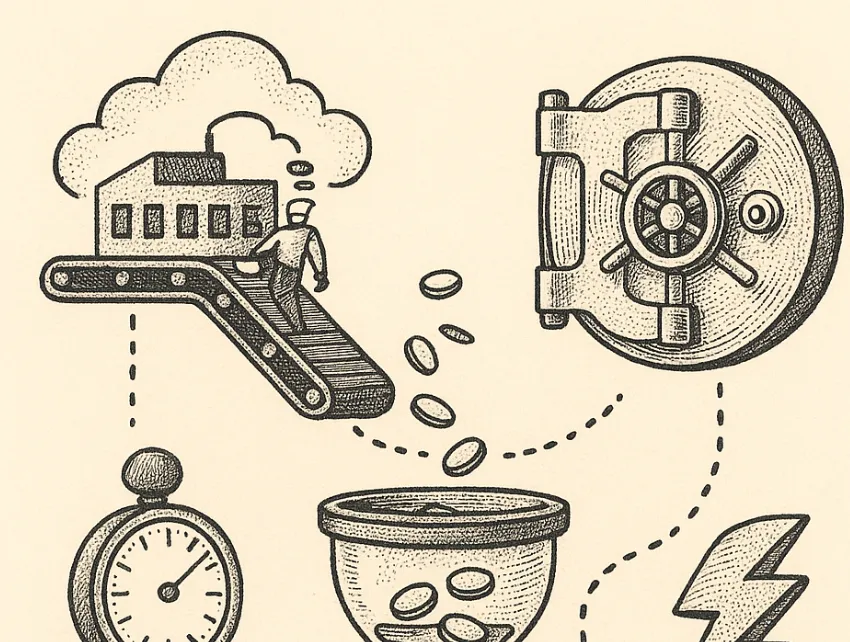
Stablecoin Payroll for DAOs: Seamless, Compliant, Instant
Empower your DAO with stablecoin payroll. Send compliant, borderless, instant payments to contributors globally—without banking delays.

.avif)
Decentralized Autonomous Organizations (DAOs) have reshaped how people collaborate and get paid online. Yet, one problem keeps resurfacing: payroll. Traditional banking systems struggle to keep up with decentralized teams scattered across borders, currencies, and time zones. Payments are often delayed, expensive, and difficult to track—especially when compliance and tax reporting enter the picture.
Stablecoins are changing that equation. By combining the stability of fiat currencies with the speed and transparency of blockchain, they offer DAOs a new way to pay contributors—instantly, globally, and without middlemen. With stablecoin payroll, DAOs can compensate members in seconds, maintain on-chain transparency, and meet compliance standards that once seemed out of reach for Web3 organizations.
In this guide, we’ll explore how stablecoin payroll systems are transforming DAO operations—from removing banking barriers to enabling real-time payments and automated compliance. You’ll learn why stablecoins are becoming the default payment rail for DAOs, how to choose the right setup, and what compliance tools can help you stay future-proof in an evolving regulatory landscape.
The Challenge: Paying a Global DAO Workforce
Managing payroll in a DAO isn’t as simple as clicking “send.” Unlike traditional companies, DAOs often have contributors in 10+ countries, all working in different time zones and paid in different tokens or currencies. Paying them through banks or platforms like PayPal quickly becomes a nightmare: high fees, slow settlement, limited access in certain regions, and compliance blind spots.
For DAOs, these limitations aren’t just inconvenient—they directly threaten trust and efficiency. A single delayed or misrouted payment can damage community confidence, discourage contributors, and create accounting chaos. Add in the fact that DAOs typically operate without a central legal entity, and suddenly payroll isn’t just an operational hurdle—it’s a regulatory and reputational risk.
That’s why forward-thinking DAOs are embracing stablecoin payrolls. They want a system that’s as decentralized and borderless as their teams, but also reliable, traceable, and compliant with emerging global standards. Stablecoins—particularly fiat-backed ones like USDC, USDT, and EUROC—bridge this gap between crypto-native operations and real-world financial accountability.
What Is a Stablecoin Payroll (and Why It Works for DAOs)
A stablecoin payroll is a payment system where contributors receive compensation in stablecoins—cryptocurrencies pegged to stable assets like the U.S. dollar or euro. Unlike volatile tokens such as ETH or BTC, stablecoins like USDC, USDT, and DAI maintain predictable value, making them ideal for salaries, bonuses, and reimbursements.
For DAOs, this is more than just a technical upgrade—it’s a philosophical match. DAOs operate without centralized management, often relying on multi-signature wallets or smart contracts to approve and send payments. Stablecoins fit naturally into this structure because they allow automated, programmable, and borderless transactions that align with how DAOs govern themselves.
How It Works in Practice
- Treasury Funding: The DAO treasury holds stablecoins or converts volatile assets (e.g., ETH) into stablecoins to minimize exposure to price swings.
- Contributor Onboarding: Contributors connect their crypto wallets (like MetaMask or Gnosis Safe) and specify payment preferences.
- Automated Payments: Payroll smart contracts distribute stablecoins instantly once contributions are verified—either through DAO votes or task-tracking tools like Coordinape or Dework.
- Compliance & Reporting: Modern DAO payroll tools integrate KYC/AML checks and generate exportable reports for tax and accounting compliance.
This system eliminates the manual headaches of traditional payroll management. No bank delays. No FX conversion errors. No waiting days for transfers to clear. Contributors get paid within seconds, with full transparency on-chain, and DAOs maintain an immutable record of every payment for audits and governance.
Why It Works for DAOs
- Decentralized by design: Matches the DAO’s non-hierarchical structure.
- Global and inclusive: No need for banking infrastructure or regional restrictions.
- Transparent: Every transaction is visible on-chain, reinforcing community trust.
- Stable value: Avoids the volatility risk of paying in ETH or governance tokens.
- Compliant-ready: Integrates smoothly with evolving regulations via identity and reporting modules.
In short, stablecoin payrolls turn what was once a logistical bottleneck into a strategic advantage—helping DAOs scale, retain top contributors, and prove financial maturity to their communities and partners.
Key Benefits of Using Stablecoins for DAO Payroll
For DAOs, switching to stablecoin payrolls isn’t just about adopting a trend—it’s about solving foundational problems that limit growth and legitimacy. From payment speed to global reach, stablecoins offer measurable improvements across every dimension of payroll management.
1. Instant, Borderless Payments
Stablecoins eliminate the friction of traditional banking rails. Instead of waiting 3–5 business days for an international wire, contributors receive funds instantly, anywhere in the world, with minimal fees.
For DAOs operating across continents—from developers in Argentina to designers in Portugal—this speed transforms productivity. Contributors no longer lose hours worrying about when or if they’ll be paid.
Example: A DAO treasury on Ethereum or Polygon can distribute $50,000 in USDC to 100 wallets in under a minute—without ever interacting with a bank.
2. Predictable Value Without Volatility
Paying contributors in ETH or BTC might seem crypto-native, but price swings can erode trust. A payment worth $2,000 today might drop to $1,600 tomorrow.
Stablecoins solve this by maintaining a 1:1 peg to fiat currencies, giving contributors confidence that their compensation holds value, and giving DAOs consistent accounting metrics.
This stability is crucial when budgeting treasury funds, forecasting costs, and maintaining credibility with new contributors.
3. On-Chain Transparency and Auditability
Every stablecoin payment is recorded on-chain, creating a transparent payroll ledger visible to the entire community. This aligns with the DAO ethos of openness and accountability.
Auditors, token holders, and regulators can all verify transactions without exposing private data, which makes DAOs appear more professional, trustworthy, and compliant.
Transparency isn’t just ethical—it’s a powerful reputational advantage in Web3.
4. Built-In Compliance Capabilities
Compliance has long been a gray area for DAOs. But modern stablecoin payroll systems integrate KYC (Know Your Customer) and AML (Anti-Money Laundering) frameworks directly into smart contracts or through hybrid APIs.
This ensures contributors are verified, taxes are traceable, and records are exportable for traditional accounting or audit reviews.
By embracing compliance early, DAOs gain access to partnerships, exchange listings, and institutional capital that would otherwise remain out of reach.
5. Cost Efficiency and Treasury Control
Cross-border wire fees and intermediary costs can consume 5–10% of every payout. Stablecoins slash these expenses to a few cents per transaction.
DAOs also gain granular control over their treasury—splitting payments, automating recurring distributions, and even streaming compensation per second via protocols like Superfluid or Sablier.
This level of control turns the treasury from a static fund into a living financial engine that supports growth, incentives, and governance.
6. Enhanced Contributor Trust and Retention
Getting paid on time is one of the simplest ways to build loyalty. Stablecoin payrolls provide a reliable, fast, and transparent system that enhances community trust.
Contributors see exactly what they earned, when it was sent, and where it sits—without needing to rely on intermediaries or opaque treasury managers.
This trust drives long-term engagement and helps DAOs attract top global talent who value speed, autonomy, and transparency over corporate bureaucracy.
Stablecoin payrolls are more than a payment method—they’re a governance and trust tool. By solving how DAOs handle compensation, they open the door for sustainable growth, better community alignment, and credible compliance in an evolving Web3 ecosystem.
Top Stablecoins for DAO Payroll (and How to Choose the Right One)
When your DAO is ready to move from fiat + bank wires to a truly global, instant payroll model, the choice of which stablecoin(s) to use becomes critical. Below is a comparison of the major contenders — and how Toku supports them — so you can pick the one best aligned with your treasury strategy, compliance burden, and contributor global footprint.
Leading Stablecoins for Payroll
1. USD Coin (USDC)
- Issued by Circle Internet Group, backed 1:1 by fiat reserves and short-term U.S. Treasuries.
- Multi-chain support (Ethereum, Solana, etc) which gives your DAO flexibility in blockchain rails.
- Strong regulatory and audit profile, which matters when your DAO wants institutional credibility.
- Best for: DAOs that need “enterprise-grade” stability, compliance and treasury predictability.
2. Tether USD (USDT)
- The largest stablecoin by market cap.
- Extremely high liquidity and broad chain/market support.
- But: Some concerns remain around transparency and regulatory clarity relative to USDC.
- Best for: DAOs operating in many chains, remittance-heavy environments, or needing max liquidity and global currency paths.
3. Dai (DAI)
- Decentralised stablecoin issued by MakerDAO, backed by crypto collateral rather than fiat.
- Offers strong Web3 “native” appeal but less institutional comfort for payroll due to the collateral model.
- Best for: DAOs already locked into DeFi-native infrastructure, willing to accept some treasury risk for decentralisation gains.
Other worthy mentions:
- PYUSD (PayPal USD) — emerging as a stablecoin backed by PayPal and Paxos, useful for more consumer-friendly rails.
- Euro-pegged or other fiat currency stablecoins like EUR Coin (EURC) — useful if your DAO has many euro-zone contributors.
How to Choose the Right Stablecoin for Your DAO
Here are key decision-criteria:
- Reserve backing & transparency: Choose a coin with audited reserves and clear redemption mechanisms (USDC scores highly here).
- Liquidity & chain support: If you’ll pay in many markets/chains, favour coins like USDT or USDC with broad coverage.
- Compliance / regulatory fit: If your DAO wants to be “compliance-ready”, lean toward those with strong institutional support.
- Treasury risk / volatility profile: Even stablecoins carry risk (peg risk, chain risk) — design your risk controls accordingly.
- Payment rails and spendability: Are contributors able to cash out, spend or swap easily in their regions?
- Multi-chain vs single-chain strategy: Some coins perform better on specific chains; your DAO’s treasury/finance architecture needs to match.
How Toku Facilitates Stablecoin Payroll for DAOs
Toku offers a strong platform for DAOs seeking to implement stablecoin payroll:
- Our “Stablecoin Payroll” offering enables global payroll in 100+ countries with built-in tax, labor law and crypto regulatory compliance.
- We support integration via API with existing payroll systems, meaning you don’t always need to rebuild your stack from scratch.
- We explicitly refer to paying teams “instantly in stablecoins or fiat” with global coverage
- Not only that, but they point out DAOs and crypto-native organizations as part of their target use cases.
For a DAO, this means you could pick your stablecoin of choice (eg USDC) and pair it with Toku’s infrastructure to manage compliance, global jurisdictional tax/vesting, wallet payouts and treasury conversion flows — all without “reinventing payroll”.
How to Set Up Stablecoin Payroll for a DAO: Step-by-Step Guide
Setting up a stablecoin payroll might sound complex at first, but modern tools like Toku make the process surprisingly straightforward. The key is to combine decentralized finance flexibility with compliant, transparent infrastructure. Here’s how to do it.
Step 1: Define Payroll Policy and Governance
Before any transaction happens, your DAO should agree on how contributors are paid:
- Which stablecoins are supported (e.g., USDC, DAI, or USDT).
- How often payments occur (weekly, biweekly, monthly, or streaming).
- How payment approval works — via multi-sig wallets, snapshot votes, or automated triggers from a project management tool.
Set clear parameters in your DAO’s governance proposal to ensure all contributors understand payout logic and conversion rates.
Step 2: Choose the Right Stablecoin(s)
If your DAO operates globally, it’s often best to diversify between USDC (for reliability) and DAI (for decentralization).
Ensure that your chosen stablecoin:
- Has strong liquidity on major DEXs and CEXs.
- Maintains a consistent 1:1 peg.
- Is supported by the chain your DAO uses most (Ethereum, Polygon, Arbitrum, etc.).
Avoid niche or regionally restricted stablecoins unless you have specific treasury reasons to hold them.
Step 3: Select a Payroll Infrastructure Provider
This is where Toku becomes indispensable.
Toku’s Stablecoin Payroll solution enables DAOs to:
- Pay contributors instantly in stablecoins across 100+ countries.
- Automate tax and labor compliance through built-in workflows.
- Offer both crypto and fiat payouts, allowing hybrid models.
- Generate compliance-ready reports for contributors and treasurers alike.
You can configure Toku to interact directly with your DAO’s treasury wallet or smart contract, ensuring a fully transparent and auditable process from payment initiation to delivery.
👉 Learn more at Toku’s Stablecoin Payroll service.
Step 4: Set Up Wallets and Contributor Profiles
Ask each contributor to provide their preferred wallet address (e.g., MetaMask, Gnosis Safe, or Coinbase Wallet).
To ensure compliance and traceability:
- Use Toku’s KYC/KYB onboarding for contributors.
- Record wallet addresses in your DAO’s payroll dashboard.
- Set permission levels for treasury signers or automation bots.
This step builds the foundation for secure and compliant distributions—protecting both the DAO and the contributors.
Step 5: Integrate with DAO Tools
For smoother operations, connect your payroll system with your existing stack:
- Task tracking: Coordinape, Dework, or SourceCred for contribution-based payments.
- Accounting: Toku or third-party APIs for automated reporting and audits.
- Governance: Snapshot or Aragon for proposal-based approvals.
The goal is to eliminate manual data entry and synchronize everything—from task completion to compensation—in one automated workflow.
Step 6: Automate and Launch
Once testing is complete, it’s time to go live.
- Run a test transaction with a small amount of stablecoins to confirm everything flows correctly.
- Schedule recurring payrolls through smart contract automation or Toku’s dashboard.
- Communicate payment schedules and transparency reports to contributors to maintain trust.
With automation, your DAO can handle payroll for 5 or 500 contributors without scaling costs or administrative overhead.
Step 7: Monitor, Report, and Optimize
Post-launch, use dashboards (like Toku’s or Gnosis Safe integrations) to:
- Track real-time payouts.
- Export CSV reports for bookkeeping or treasury meetings.
- Adjust frequency, currencies, and allocations as contributor needs evolve.
Over time, this transforms payroll into a living system of financial transparency—a competitive advantage for attracting top talent and institutional partners.
Pro tip: DAOs that implement stablecoin payroll with Toku often experience a 50–70% reduction in admin time and near-zero payment delays compared to manual crypto transfers.
Stablecoin Payroll Is the DAO Standard of the Future
The way DAOs operate is evolving—and so is how they pay their people. Stablecoin payroll isn’t just another crypto experiment; it’s becoming the operational backbone of serious Web3 organizations.
By leveraging stablecoins, DAOs can pay contributors instantly, maintain financial transparency, and stay compliant in a regulatory landscape that’s tightening by the day. The combination of speed, stability, and compliance makes stablecoin payroll a long-term foundation, not a short-term hack.
Tools like Toku make this transition seamless. They bridge the gap between decentralized freedom and real-world accountability—helping DAOs automate payouts, meet compliance requirements, and scale globally without friction.
In a space built on trustless technology, trust still matters. Paying your contributors on time, transparently, and in stable value is one of the strongest ways to prove that your DAO isn’t just decentralized—it’s dependable.
The future of DAO payroll is already here
It’s compliant.
It’s instant.
It’s stablecoin-powered.







